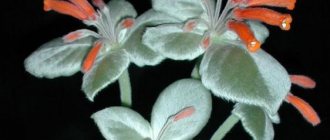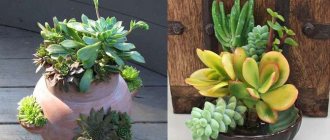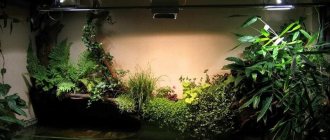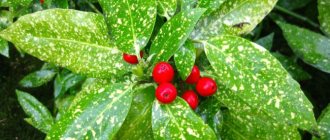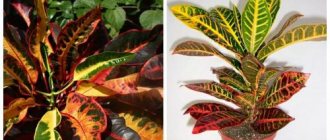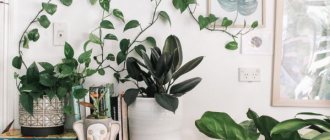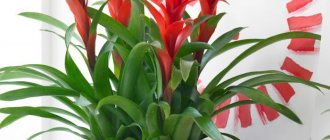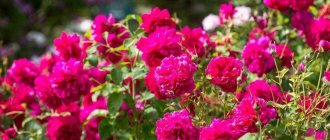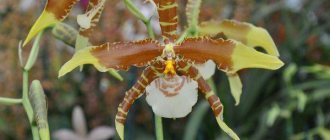Indoor plants are what add comfort and harmony to any home. Fresh flowers make a home more complete and enjoyable.
Monster
But if you want them to bloom and grow for a long time, you need to know their characteristics when planting and caring for them, because each plant with large leaves is different from each other.
Abutilone
There is a beautiful plant from the mallow family, also known as the indoor maple. And for good reason—these large-leaved, peaceful plants are something of an heirloom tree. Abutilon blooms with bright, large flowers that are pleasing to the eye and add elegance to any home. The flowering period is quite long - from May to October, so you can enjoy all this splendor. The plant loves warmth, about 20-30 degrees, but not lower than 15 degrees in winter. Water thoroughly and keep in a sunny location.
Peperomia
Peperomia is a large genus of perennial herbs from the Pepper family. About 1000 species are found in nature, and about 30 peperomia are grown at home. This plant is similar to Crassula in its dense, rounded leaves and thick stems. The plant is native to the arid regions of South Africa.
The main difference between peperomia and money tree is not its external features, but its ability to survive. This plant is less hardy. It is especially demanding regarding light - it must be diffused, and watering - they need not abundant, but regular moisture.
Avocado
Everyone has heard the name of this beautiful plant that came to Europe from America. Currently, avocado has become a common plant in Russia. Thanks to its large stature, it can grow up to 20 meters in height. It can be used as a houseplant or to decorate porches and outdoor patios. Indoors it can reach a height of up to 1 meter. Its elongated, long, thick leaves grow in a bush-like shape, making it an ideal addition to any corner of the home. Avocados love high humidity, so they should be watered frequently.
The name of an indoor flower with long narrow leaves is Calamus (with photo)
Calamus (Acorus gramineus)
Narrow, reedy leaves grow up to 50 cm in height from a rhizome, part of which is located above the ground. Calamus (Acorus gramineus) 'Variegatus' is an indoor flower with long narrow leaves, distinguished by its yellow color, 'Albovariegatus' - with white stripes. The particularly low-growing variety 'Pusillus' grows only up to 10 cm.
Family: Agaseae (Araceae).
The homeland of the flower with long narrow leaves: Japan, China, Thailand, India.
Temperature. Likes room temperature in summer, from 0 to 18 °C in winter.
Air humidity. No particular preference.
Substrate. Flower soil mixture with a slight addition of loam.
Watering. Place the pot in a tray with water.
Feeding. In spring and summer every 2 weeks, in winter every 6 weeks.
Transfer. If necessary.
Reproduction. By dividing the rhizome in the spring.
Pests, diseases. Rarely.
Important Air! - a marsh plant, it should under no circumstances dry out!
Look at this flower with long narrow leaves in the photo and the name will be remembered by itself, since the appearance of the crop is very characteristic:
Anthurium
One of the exotic and beautiful tropical plants, which is also called flamingo flower. It owes its name to its unusual and beautiful appearance. Many people often wonder how to find out the name of a houseplant with unusually shaped flowers. Anthurium is one of the most magnificent plants in the flower world. Its leaves are quite large and heart-shaped, and its flowers are unusual. They are bright and shiny and resemble little hearts. Anthuriums come in different types and colors, so you can choose a flower for any interior.
Caring for Succulents
The most famous types of succulents: Kalanchoe, aloe, cactus, crassula.
These plants can be seen in almost every office or apartment. These flowers do not require special care; they can go without water for a long time, maintaining an attractive appearance. But minimal comfort is necessary for these plants.
Lighting
Succulents are found in arid climates where the sun shines brightly, so at home the flowers need to be provided with good lighting. Experts recommend placing pots with plants on south, east and west windows (preferably installed on the south side). But we also must not forget that not all succulents like bright light; some of them cannot tolerate direct sunlight. Agave and cacti love the sun the most, but aloe and crassula can dry out due to too much light. The last two types should be shaded with something and placed on the eastern windows.
In the cold season, plants need 12-14 hours of daylight, so in the evening you need to turn on the light bulb, which should be installed at a height of 35 cm from the flower. Only when choosing lamps, give preference to a special phytolamp, thanks to which the plant will receive enough bright light. Luminescent ones do not heat up enough and reduce the intensity of light emission.
Air
In order for flowers to develop normally, they need sufficient air. The roots of succulents need air most of all, so for such flora you need to purchase loose, rocky soil. Succulents react normally to drafts, but in the hot season they need to be planted in a flower bed or simply take pots of flowers out onto the terrace or veranda.
Experienced gardeners recommend periodically spraying plants.
Watering
Since succulents originally grew in hot climates, excess moisture should not be allowed. Constant watering is more destructive for these plants than lack of water, so they need to be watered moderately and carefully.
When the succulents actively develop and bloom (blooming occurs from late spring to early autumn), watering should be done in small portions 1-2 times every 7-8 days. The rest of the time, plants need to be watered once every 9-12 days.
In winter, care must be taken when watering. It is enough to pour water into the pots once a month.
Temperature
During the flowering period in summer, succulents need a temperature of +26...+32 °C during the day, and +16...+22 °C at night. In winter, spring and autumn, +16...+20 °C during the day, and +6...+7 °C at night will be enough for them.
Fertilizers
Succulents, of course, are unpretentious, but they, like other plants, need periodic feeding. Beginning gardeners should remember that these indoor flowers cannot be fed with organic fertilizers, as they will cause the roots to rot. It is better to purchase special mineral substrates that contain useful elements. Professionals recommend using the highest quality fertilizers, for example, Agricola or Bona Forte. Thanks to their balanced composition, these products will help succulents develop fully.
During flowering, fertilizing should be done once every 35 days (in spring and summer). The rest of the time there is no need to feed the plants.
Dry feeding is not intended for succulents, so you need to apply an aqueous solution of the substrate under the root.
You can also purchase the biological product “Fitosporin M”. It contains useful components that stimulate plant growth. A special solution based on a biological product must be prepared 2.5 hours before use.
It is worth noting that you can feed succulents at home even without a special substrate. Nutrient fertilizer is made from wood ash. Just fill the substance with boiled water, keeping the proportions 1:3 and leave to brew for a day. The plants can be fed with the resulting mass 2 times in 30-40 days. If you decide to water flowers with ash, then this solution must be diluted with water (1:10).
Having learned which indoor plants with fleshy leaves are quite unpretentious, owners can safely purchase flowers and not spend a lot of time and effort caring for them.
Alocasia
This large plant is also called elephant ear. It is not named so in vain, because it has no equal in the beauty and size of its leaves. Its dark-colored leaves are very large and flat. Alocasia grows quickly and can reach a height of 1.5 meters. Its beautiful shape and size make it an ideal ornamental plant for large areas. However, keep in mind that it is quite difficult to care for. Alocasia loves warmth and grows well at temperatures not lower than 18 degrees. It also requires constant soil moisture and fertilization.
Aspidistra
This plant is well known in the East and is widely cultivated in China and Japan. Due to its hardiness and undemanding nature, it is called the iron flower. It has almost no stems, and the leaves grow from the ground. Thanks to their thick, elongated shape, they look great in any room and create a cozy atmosphere. Aspidistra is easy to grow and very easy to care for. Plants should be kept out of direct sunlight as they are shade-tolerant. Ideal for decorating stairs and indoor corridors. Aspidistra is available in various varieties, both with plain leaves and as a houseplant with white-green leaves. A pattern of bright stripes runs along the entire length of the sheet in thin stripes.
Names of popular houseplants with large green leaves
Home indoor flower with purple leaves
In addition to narrow-leaved flowers, people often grow other crops. There are several of the most popular indoor plants with large green leaves.
Big leaves
Plants with large leaves include the following:
- Monstera. An evergreen flower from the liana family. Young leaves are wide and whole, but with age they become dark and holey. It is worth considering that even at home it reaches a large size
- Aglaonema. Belongs to the Araceae family. The plant is practically without a stem, the leaves are large green-white, from 1 to 3 ears grow on the top, which are flowers.
Monstera in adulthood really looks like a monster
Wide leaves
Broad-leaved crops include the following types:
- Anthurium. A houseplant with large, green, heart-shaped leaves reaching 15 cm in length and 7 cm in width. The flower does not like excessive watering, drafts and dark places.
- Dieffenbachia. A popular indoor flower with large spotted leaves. Perfectly purifies the air from various toxic substances. It is quite easy to care for, but it is recommended to carry out all manipulations with gloves to avoid poisoning by alkaloids contained in the juice.
Important! Dieffenbachia is a houseplant with variegated leaves that is considered poisonous. However, you can place it in residential areas, you just need to pay closer attention to animals and small children.
Thick and fleshy leaves
There are domestic crops whose leaves are thick and fleshy. Similar plants include:
- Aloe. An undemanding flower that is famous for its beneficial properties. The leaves grow in a circle, are long in shape with sharp edges, slightly prickly due to small thorns. Sometimes it comes with white dots and spots.
- Crassula. The famous money tree with thick round leaves. The flower has a rather massive trunk with branches on which leaves grow. Does not require special care, does not like excess moisture.
- Zamioculcas. The plant is called the dollar tree. It consists of many stems with leaves on them. Loves sunny places, does not like low temperatures. In general, the plant is not whimsical.
Crassula - the famous money tree
Dieffenbachia
Originally from Brazil, this plant has become popular in Europe due to its beautiful appearance and unpretentiousness. Dieffenbachia is easily recognizable among many other plants due to its exotic appearance. Its large, smooth leaves have unusual whitish-cream spots along their entire length. It is often used to decorate various rooms.
Dieffenbachia
Dieffenbachia is easy to care for. It can grow unhindered in a warm room without direct sunlight. With a lack of light, the leaves lose their color and the white spots become dull. Water sparingly and mist frequently.
Indoor maple
The second name for a tall indoor plant is abutilone. This flower is no less popular than hibiscus. And this is not surprising, because indoor maple is also unpretentious in care and produces buds almost all year round. And it’s always pleasant to look at its flowering, since abutilon’s peduncles are large and variegated. In addition, they densely cover the bush, giving it the appearance of a bright ball. In addition, this plant tolerates pruning well.
Exotic handsome man loves light. Therefore, grow it in the south or east side of the room. And in the summer, safely take the pot out onto the balcony or into the garden. But do not forget to shade the flower from the midday rays of the sun, otherwise the leaves will fall off. And protect the plant from wind and drafts. From spring to autumn, water indoor maple trees abundantly, avoiding the soil from drying out. In winter, reduce watering, but monitor the condition of the soil. And under no circumstances keep the pot near heating appliances. Due to dry and hot air, the leaves turn yellow and fall off.
Maranta
This unusual and colorful plant grows in Central America. Arrowroot is one of the most wonderful plants that can be found in any home today. It is quite low-growing and short-stemmed, with beautiful, bright, oblong leaves. Bright burgundy and cream leaves run throughout the foliage, giving the flower a distinctive pattern. Maranta loves warmth and sunlight. Store at a temperature not lower than 18 degrees. Constant watering and spraying will ensure longevity for this plant.
And for a long time it will decorate any room with its unusual beauty.
Monstera
Monstera is another unusual and exotic plant brought to Europe from Central America. Monstera is easily recognizable among many other flowers due to its unusual appearance. Its large leaves are deeply cut and oblong in shape. Thanks to its beauty, Monstera has gained popularity among flower growers around the world. Since it is a tropical plant, it loves high humidity and warmth. Another distinctive feature of this flower is its aerial roots that grow above the soil. They should never be trimmed.
Syngonium
The homeland of this plant is South America, but it has also taken root in Europe. Due to its unusual appearance and large size, syngonium has become quite popular. The plant has a long stem ending in beautifully shaped leaves. Syngonium belongs to the vine family and will grow tall and curl at the top of the plant if it finds support. The plant is quite undemanding and grows at temperatures not lower than 18 degrees. Wipe and spray the leaves daily, water, albeit moderately, but constantly. Excessive watering can cause leaves to rot. With proper care, the syngonium will decorate any home for a long time.
Non-flowering houseplants
Sansevieria (mother-in-law's tongue, pike tail) is the most unpretentious indoor flower. It belongs to the Agave family and, like many of its other representatives, is simply an indestructible plant. It will grow both on the south window and in a dim corner. But in bright light the leaves will have a more intense color. As a succulent, this plant does not need much watering. In summer it is enough to water once a week. In winter, you don’t have to water it at all. But excess moisture can lead to rotting of the roots. Since this flower grows rather slowly, it can be replanted every few years. No need to feed. Sansevieria easily tolerates both dry and moisture-saturated air. Not at all afraid of drafts. Thanks to its unpretentiousness, it can decorate cold foyers and halls.
Scindapsus
Scindapsus is also one of the most popular and very unpretentious indoor plants. This fast-growing vine with a tetrahedral stem and bright glossy heart-shaped leaves decorated with white or yellow spots is familiar to everyone since childhood. This plant is absolutely not demanding on the soil; it can grow for years in a container with water. It takes root easily, and under suitable conditions acquires luxurious large leaves. Scindapsus easily climbs along any support provided and is able to cling even to plaster with its aerial roots. If you pinch the tops of the shoots, the plant will be denser and more beautiful. It must be borne in mind that the flower can only grow under artificial light.
Dracaenas are a very stylish home or office plant. There are many types of dracaenas, some of them can withstand conditions that seem absolutely unsuitable for exotic plants. For example, dracaena fringed and Draco can grow in very dark rooms, requiring minimal watering and without transplanting or fertilizing. However, species with broad leaves need stronger light and frequent watering. Undemanding to temperature conditions. In winter they tolerate temperatures below +10 ºС, in summer they can withstand dry air of +35 ºС. All dracaenas grow very slowly, so they can be replanted once every 5 years or less.
Aloe is one of the most popular plants
The well-known aloe is also an unpretentious houseplant. There are several varieties of this very useful flower. Aloe tree looks like a small tree or shrub with an erect stem and succulent, fleshy, narrow-lanceolate leaves of a matte green color. Very beautiful are the dense basal rosettes of broadly lanceolate leaves with white hooked spines and a colorless awn at the end of Aloe spinosa. Scarlet tiger rosettes also look impressive. The most useful of indoor flowers is considered to be true aloe, or Barbados (Aloe vera, barbadensis), with narrow, jagged, bluish-green leaves. The only condition for the successful existence of these plants is bright light, so they need to be placed on window sills.
Aloe Barbados
In summer, aloe can be watered once every 3 days, in winter - once a week. Aloe juice is widely used in traditional medicine recipes and has valuable medicinal and cosmetic value. The plant itself actively absorbs harmful substances from the air and has very high phytoncidal activity against many pathogens.
Scheffler
Native to Australia, this plant is popular for its tall growth and beautifully shaped leaves. Its decorative appearance will decorate any room and make it cozy and beautiful. Schefflera is also known as the umbrella tree. It gets its name from its long, thick stem that makes it look like a small tree, with small leaves that open out like umbrellas at the ends. The unusual shape of the leaves is one of the most characteristic features of this plant. Schefflera requires regular watering and tolerates shade.

